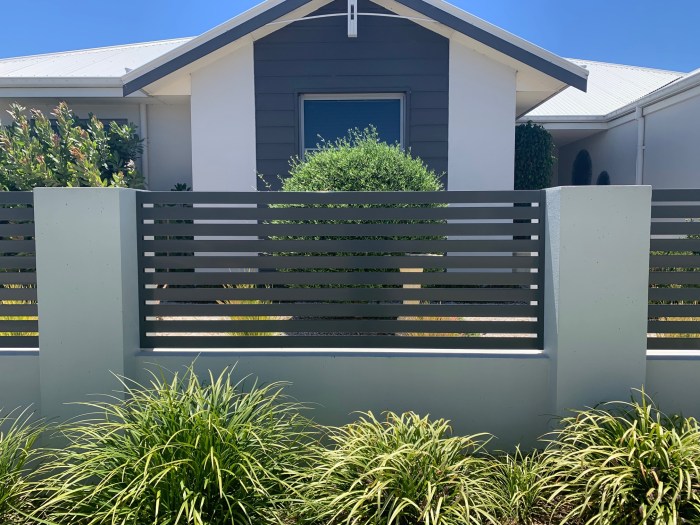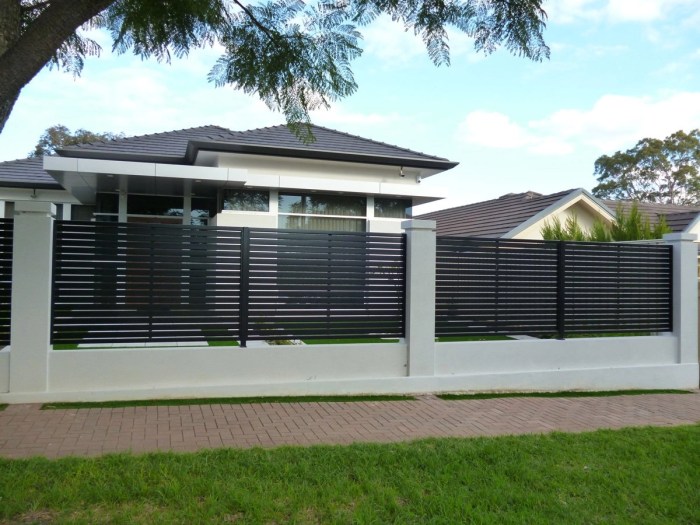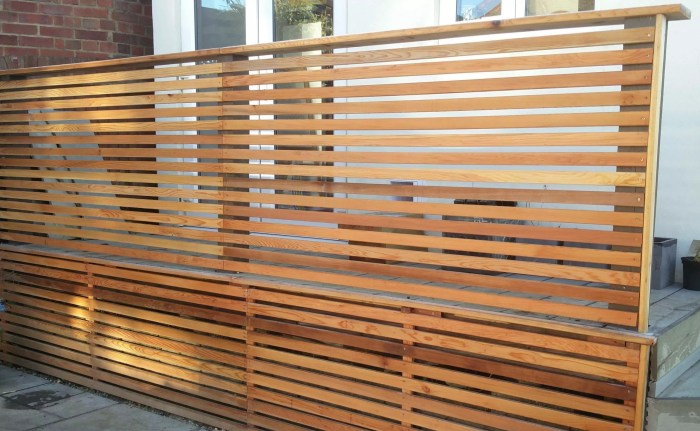Discover the captivating world of slat fence ideas, where design meets functionality, offering endless possibilities to transform your outdoor haven into a private oasis. Immerse yourself in an exploration of styles, materials, and techniques, unlocking the secrets to creating a fence that not only enhances privacy but also complements your home’s aesthetic.
From traditional charm to modern elegance, the diverse styles of slat fences cater to every taste. Explore the durability and cost-effectiveness of wood, vinyl, and metal, understanding their unique characteristics and maintenance requirements. Learn the art of slat spacing and orientation, optimizing privacy, ventilation, and visual appeal.
Design Styles
Slat fences offer a versatile canvas for expressing your design preferences. From traditional to modern and rustic, various styles cater to different tastes and architectural aesthetics.
Let’s dive into the key characteristics, advantages, and drawbacks of each style to help you make an informed choice:
Traditional
- Vertical slats with evenly spaced gaps
- Classic and timeless look
- Suitable for a wide range of properties
- May require regular maintenance to prevent warping or rotting
Modern
- Horizontal or vertical slats with wider gaps
- Clean and contemporary aesthetic
- Can provide privacy while allowing light and air to pass through
- May be more susceptible to wind damage
Rustic
- Natural wood slats with uneven gaps
- Warm and inviting look
- Ideal for cabins, cottages, and outdoor living spaces
- Requires regular sealing to protect against the elements
Material Options

Slat fences can be constructed from various materials, each offering unique advantages and drawbacks. Choosing the right material depends on factors such as durability, cost, maintenance requirements, and aesthetic appeal.
Here are some of the most common materials used for slat fences:
Wood
- Natural and aesthetically pleasing
- Durable with proper maintenance (staining, sealing)
- Can be expensive to purchase and install
- Requires regular maintenance to prevent rot and decay
Vinyl
- Durable and weather-resistant
- Low maintenance (no painting or staining required)
- Can be more expensive than wood
- May fade or discolor over time
Metal
- Strong and durable
- Low maintenance (no painting or staining required)
- Can be more expensive than wood or vinyl
- May rust or corrode over time
Slat Spacing and Orientation
The spacing and orientation of slats play a crucial role in determining the overall look, privacy, and ventilation of your slat fence.
Wider slat spacing allows for greater visibility and air circulation, making it suitable for areas where privacy is not a top concern. Conversely, narrower spacing enhances privacy by limiting visibility, but may also restrict airflow.
Vertical Orientation
- Offers maximum privacy, as the vertical slats create a solid barrier.
- Provides limited ventilation compared to horizontal orientation.
Horizontal Orientation
- Provides more ventilation due to the gaps between slats.
- Offers less privacy than vertical orientation, as the slats allow for some visibility.
Diagonal Orientation
- Combines elements of both vertical and horizontal orientations.
- Offers moderate privacy and ventilation.
- Creates a unique and visually appealing aesthetic.
Height and Privacy

The height of a slat fence directly influences the level of privacy it provides. Taller fences naturally offer greater seclusion, as they obstruct the line of sight and prevent individuals from peering over or through the slats. However, it’s important to consider local building codes and regulations regarding fence height restrictions.
In addition to height, the spacing and orientation of the slats also impact privacy levels. Wider slat spacing allows for more visibility, while narrower spacing creates a more opaque barrier. Vertical slats provide a greater degree of privacy compared to horizontal slats, as they block direct lines of sight.
Slat Spacing and Privacy
- Narrow slat spacing: Increased privacy due to reduced visibility.
- Wide slat spacing: Decreased privacy due to increased visibility.
Slat Orientation and Privacy
- Vertical slats: Enhanced privacy by blocking direct lines of sight.
- Horizontal slats: Reduced privacy due to gaps between the slats.
Decorative Elements
Slat fences provide ample opportunity for decorative enhancements, transforming them from mere barriers into captivating visual accents. These elements elevate the aesthetic appeal and create visual interest, making your fence stand out as a focal point in your outdoor space.
Incorporating decorative elements into slat fences is a creative endeavor, allowing you to express your personal style and complement the surrounding landscape. Here are a few ideas to inspire your decorative vision:
Finials
- Finials, the crowning glory of posts and gates, add a touch of elegance and sophistication to slat fences. These ornamental toppers come in various shapes and sizes, from classic ball finials to intricate fleur-de-lis designs. They create a sense of grandeur and draw attention to the vertical lines of the fence.
- Finials can be made from different materials, such as wood, metal, or composite, to match the overall style of the fence. They can be painted in vibrant colors or left in their natural finish for a more rustic charm.
Latticework
- Latticework, a delicate interlacing of thin wooden or metal strips, adds a touch of intricacy and visual interest to slat fences. It can be incorporated as decorative panels between slats or as a topper, creating a charming and airy effect.
- Latticework allows for creative customization, with various patterns and shapes to choose from. It can be painted in contrasting colors to create a bold statement or stained to match the fence for a more subtle touch.
Paint
- Paint is a versatile tool that can transform a slat fence into a vibrant canvas. By applying a fresh coat of paint, you can create a cohesive look with your home’s exterior or add a pop of color to the landscape.
- When choosing a paint color, consider the style of your home and the surrounding environment. Bold colors like navy or emerald green can make a statement, while neutral tones like white or gray can create a more classic and timeless look.
Landscaping Integration

Slat fences seamlessly blend into the surrounding landscape, offering both functionality and aesthetic appeal. They serve as versatile tools for creating privacy, defining boundaries, and enhancing outdoor living spaces.
Creating Privacy Screens
- Tall slat fences, closely spaced, effectively shield outdoor areas from prying eyes, creating secluded havens for relaxation and entertainment.
- Varying slat heights and widths adds visual interest while maintaining privacy, allowing for glimpses of the surroundings without compromising seclusion.
Defining Boundaries, Slat fence ideas
- Slat fences mark property lines, defining clear boundaries while maintaining a sense of openness and connection with the surroundings.
- Low-height slat fences act as subtle barriers, visually separating spaces without obstructing views.
Enhancing Outdoor Living Spaces
- Slat fences create cozy nooks and intimate seating areas, providing shelter from sun and wind.
- Vertical slat fences serve as trellises for climbing plants, adding greenery and privacy while softening the fence’s appearance.
Construction Techniques: Slat Fence Ideas

Constructing a slat fence involves meticulous steps to ensure durability and aesthetic appeal. The process encompasses post installation, slat attachment, and finishing touches.
Post Installation
Begin by marking the fence line and digging holes for the posts. Posts should be spaced evenly, typically 6-8 feet apart. Insert the posts into the holes and secure them with concrete or gravel. Ensure posts are level and plumb using a spirit level.
Slat Attachment
Attach horizontal rails to the posts using screws or nails. Space the rails evenly to create the desired slat spacing. Measure and cut slats to the appropriate length. Attach the slats to the rails using screws or nails, ensuring they are evenly spaced and aligned.
Finishing
Apply a sealant or stain to protect the fence from weather elements. Consider adding decorative elements such as finials or latticework for a customized touch. Regularly inspect and maintain the fence to ensure its longevity.
Maintenance and Repair
Slat fences require regular maintenance to keep them looking their best and extend their lifespan.Cleaning is essential to remove dirt, dust, and debris that can accumulate over time. Use a soft brush or a hose with a gentle spray nozzle to avoid damaging the slats.Staining
or painting can help protect the fence from the elements and enhance its appearance. Apply a sealant or a UV-resistant finish to provide additional protection against fading and rot.Repairs are necessary to address any damage or deterioration. Inspect the fence regularly for signs of rot, fading, or damage.
Replace damaged slats promptly to prevent further damage.
Inspiring Examples

Prepare to be mesmerized as we unveil a captivating gallery of slat fence designs that will ignite your imagination and inspire your next outdoor project.
Each example showcases a harmonious blend of materials, dimensions, and unique features, providing endless possibilities for customization. Dive into this visual feast and discover the transformative power of slat fences.
Modern Masterpiece
- Materials: Durable ipe wood with a rich, warm hue
- Dimensions: 6 feet tall, with 1-inch-wide slats spaced 1.5 inches apart
- Unique Features: Clean lines and a minimalist design create a sophisticated and contemporary aesthetic
Final Summary
As you embark on your slat fence journey, let these ideas inspire you to create a captivating outdoor space that reflects your personal style. Whether you seek privacy, define boundaries, or simply enhance your surroundings, a slat fence can transform your backyard into an inviting sanctuary.
Key Questions Answered
What are the most popular slat fence styles?
Traditional, modern, and rustic styles are widely popular, each offering unique characteristics and aesthetic appeal.
Which material is most durable for slat fences?
Wood offers natural beauty and durability, while vinyl provides low maintenance and longevity, and metal ensures strength and longevity.
How does slat spacing affect privacy?
Narrower slat spacing provides increased privacy, while wider spacing allows for more light and ventilation.


